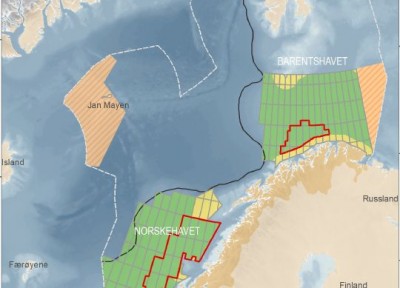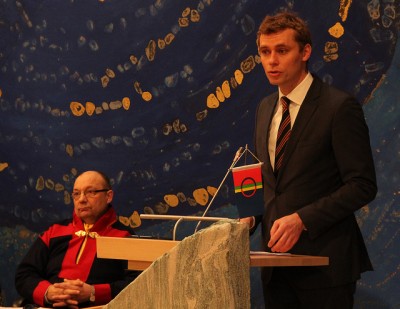The Norwegian Petroleum Directorate (Oljedirektoratet, NPD) unveiled new studies of southeastern portions of the Barents Sea and the area around the Arctic island of Jan Mayen on Wednesday, and predicted the sea floor contains enormous amounts of oil and gas. The new resources are expected to boost earlier estimates of undiscovered resources by at least 15 percent, perhaps much more.

It’s the first time that NPD is making estimates about unopened areas of Norway’s Continental Shelf after Norway and Russia agreed on borders in the Barents two years ago. NPD has since studied and mapped tens of thousands of square kilometers of the seafloor north of Finnmark with seismic equipment.
The results seem to confirm that Norway’s oil and gas era will continue for many years.
The new increased estimates amount to around 390 million standard cubic metres of oil equivalents, said NPD chief Bente Nyland at a public meeting with Oil and Energy Minister Ola Borten Moe in the northern city of Alta Wednesday afternoon. That in turn amounts to around 2.45 billion barrels of oil equivalents, or, reported Norwegian Broadcasting (NRK), more than three times Statoil’s combined oil production in 2011. At current oil price levels, the oil alone would be worth around NOK 180 billion.
“This is great news for Norway,” said Moe, a minister known for being bullish about Norway’s oil and gas industry and keen to open up new areas for exploration and production. “These increased resources represent enormous values for Norwegian society.”
Moe called the news “especially good for Northern Norway,” which is now “seriously positioned as Norway’s next oil province.”

In the Barents alone, researchers expect that there’s at least 30 percent more oil and gas than earlier thought, according to a statement from Moe’s ministry, with possibilities that the amount could be double. In the Norwegian Sea around Jan Mayen, geological estimates indicate more resources than in the Barents.
Actual discoveries can only be made, the ministry noted, by allowing the area to be opened up for petroleum operations with new wells drilled. That’s unpopular with environmental advocates and those worried about climate change in an area already hit by rapidly melting ice.
The area is also known for its extremely harsh weather conditions, and the difficulty and expense they will mean for any drilling. Some oil companies are skeptical about exploring in the area, others are extremely eager.
NPD officials believe there is more gas than oil lurking under the often stormy water. They said the Bjarmeland Platform farthest north in the portion of the Barents studied and the Fedinsky High field in the east are considered to be pure gas provinces, while the Nordkapp Basin, Tiddlybank Basin and Finnmark Platform can offer a mixture of oil and gas. At Fedinsky High, Norway’s petroleum officials believe petroleum deposits span the border between Norway and Russia.
They maintain that “the most important precondition for the formation of hydrocarbons in an area is whether there are source rocks present. The NPD is of the opinion that there is reason to believe there are source rocks that have formed sufficient volumes of gas, but that the source rocks that form oil are not present to the same extent.”
‘Huge possibilities’
Estimates of undiscovered resources around Jan Mayen to the west were more uncertain even after the seismic exploration and collection of rock and minerals. NPD expects to find 90 million cubic meters of oil equivalents, but there’s been no drilling there like there has been in some areas of the Barents. Their lowest estimate was zero, the highest 460 million cubic meters.
Nyland of NPD was impressed herself by the new resource estimates. “What we’re doing now is updating the resources in the Barents by a third,” she told NRK. “We see that we can have more faith in gas than oil, and we see huge possibilities in the region in the future.”
She called NPD’s results “great news for the oil industry.” She cautioned, though, that “these are just estimates. There’s no guarantee there actually is oil or gas in these areas.” Comparisons started flowing quickly though, for example that the estimates equalled eight new Goliat fields or one-and-a-half times the Snow White field. And she wasn’t surprised by the huge amounts being bandied about.
“We have Sjtokman on the one side (in Russian territory, in the eastern Barents) and Skrugard and Havis on the other side (in Norwegian territory to the west),” she said. “But we have to drill to be sure.” No production can be expected before 2025 to 2030.
Views and News from Norway/Nina Berglund
Please support our news service. Readers in Norway can use our donor account. Our international readers can click on our “Donate” button:

